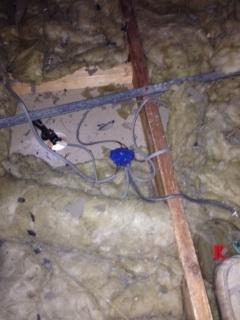In the process of refitting our bathroom and decided to replace the existing downlights as they're looking tired. There are three 240v units, with a fourth 240v unit above the current shower that also has a 12v fan unit enclosed. I got a bit of a shock (pardon the pun) when inspecting the 'wiring' in the loft. I've put some pictures below:
This second picture shows in detail what was underneath the blue tape.
So it certainly doesn't look at all good, and most probably does not conform to any regulations. At the moment the main feed from the switch comes into the 'choc block' and the lights are daisy chained from that. To that end I've decided to replace the lot. However I'm confused on the best way forward?
Is it best to go for low voltage? I'm assuming I'll need the correct rated unit with a fan to use above the new bath that will have an overhead shower? With regard to the low voltage units is it better to have one transformer per unit, or one transformer rated to provide enough power for the four units?
I'm happy working with electricity as I do so at work often (HV and LV) however I'm not sure about domestic regs (I'm in Scotland) so if someone is able to advise on the best way forward in terms of units to purchase, and what wiring configuration to use I'd really appreciate it.
This second picture shows in detail what was underneath the blue tape.
So it certainly doesn't look at all good, and most probably does not conform to any regulations. At the moment the main feed from the switch comes into the 'choc block' and the lights are daisy chained from that. To that end I've decided to replace the lot. However I'm confused on the best way forward?
Is it best to go for low voltage? I'm assuming I'll need the correct rated unit with a fan to use above the new bath that will have an overhead shower? With regard to the low voltage units is it better to have one transformer per unit, or one transformer rated to provide enough power for the four units?
I'm happy working with electricity as I do so at work often (HV and LV) however I'm not sure about domestic regs (I'm in Scotland) so if someone is able to advise on the best way forward in terms of units to purchase, and what wiring configuration to use I'd really appreciate it.




